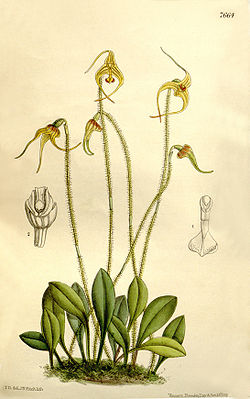This article needs additional citations for verification .(January 2015) |
| Porroglossum | |
|---|---|
 | |
| Porroglossum muscosum 1899 illustration [1] | |
| Scientific classification | |
| Kingdom: | Plantae |
| Clade: | Tracheophytes |
| Clade: | Angiosperms |
| Clade: | Monocots |
| Order: | Asparagales |
| Family: | Orchidaceae |
| Subfamily: | Epidendroideae |
| Tribe: | Epidendreae |
| Subtribe: | Pleurothallidinae |
| Genus: | Porroglossum Schltr. |
| Synonyms [2] | |
LothianiaKraenzl. | |
Porroglossum (from Greek "far off" and "tongue", referring to the position of the lip) is a genus of orchids native to the Andes of South America. The center of diversity lies in Ecuador, with many of the species endemic to that country, though others are found in Colombia, Venezuela, Peru, and Bolivia. [2] [3] This genus is abbreviated Prgm in horticultural trade.
Contents
The lip in this genus is unique in the family. It is hinged and has a mechanism that snaps shut when stimulated by a pollinator, thus trapping the insect to ensure that the pollinia will be removed and later transferred to the receptive surface. The lip opens after 30 minutes or so to release the insect, but also closes at night and reopens at dawn.
